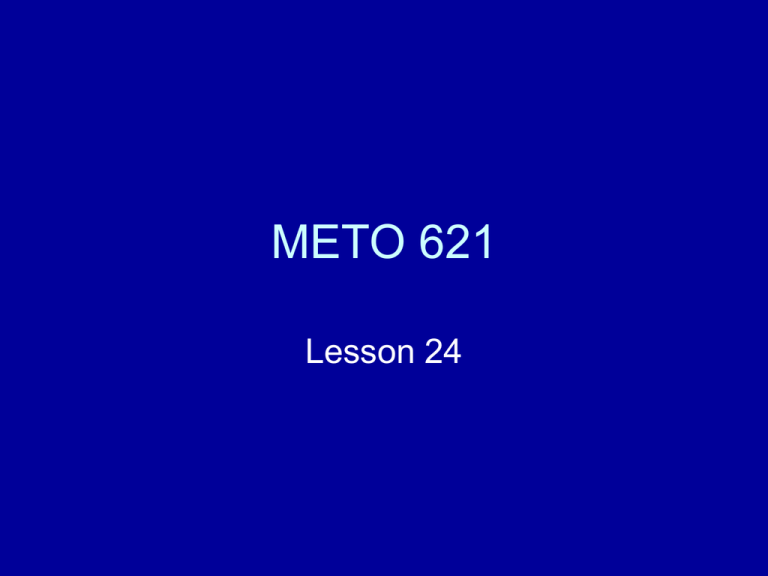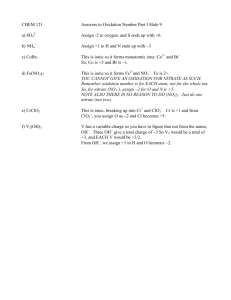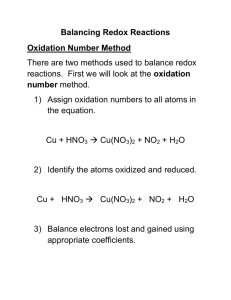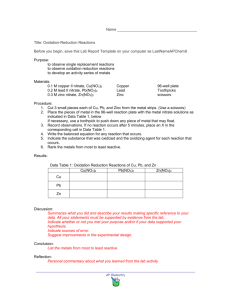METO 621 Lesson 24
advertisement

METO 621 Lesson 24 The Troposphere • In the Stratosphere we had high energy photons so that oxygen atoms and ozone dominated the chemistry. • In the troposphere we have lower energy photons, and the chemistry is dominated by the OH and NO3 radicals. • OH is generated photochemically (i.e. only during the day), NO3 is rapidly photolyzed during the day, so it can only survive at night. • NO3 is generally less reactive then OH, its peak concentration is higher. • OH provides an efficient scavenging mechanism for both natural and anthropogenic trace constituents Dry and Wet Deposition • Dry deposition – removal of gases and particles by a direct transfer from the atmosphere to the surface. • Wet deposition – removal of gases and particles carried to the surface in water – rain, snow, fog etc. • Dry deposition is known for SO2, O3, CO2, and SO3. • Wet deposition of gaseous species requires that they be water soluble. Terms used are rainout, or washout. • Acid rain is an example of the rainout of sulfurous and nitric acids, produced in polluted atmospheres. Dry and Wet Deposition Oxidation and Transformation • Let us assume that no methane has been oxidized. • Then OH is produced by the following reactions O3 + hn → O*(1D) + O2(1Dg) O*(1D) + H2O → OH + OH • It should be noted that the O*(1D) does not stay around for long, and is quenched to the ground state. The ground state then quickly combines with molecular oxygen to reform ozone. • The OH formed reacts mainly with CO and CH4 OH + CO → H + CO2 OH + CH4 → CH3 + H2O Oxidation and Transformation • These compounds then react with molecular oxygen H + O2 + M → HO2 + M CH3 + O2 + M → CH3O2 + M • If the concentration of NO is very low then further reactions convert the peroxy radicals to water vapor and carbon dioxide. • However if the nitrogen oxides are present then we get HO2 + NO → OH + NO2 CH3O2 + NO → CH3O + NO2 • This then followed by NO2 + hn → NO + O O + O2 + M → O3 + M Oxidation and Transformation Oxidation and Transformation • Analogous reactions can be written for the higher hydrocarbons, e.g. C8H18 – octane. • If we assign the formula RH to these hydrocarbons then we get RH + OH → R + H2O R + O2 + M → RO2 + M RO2 + NO → RO + NO2 • This is the basis of photochemical smog. • The photolysis of the resultant NO2 is the only known way of producing ozone in the troposphere. • The RO is further reduced to aldehydes and other organic compounds by OH, all of which can eventually produce ozone. Oxidation and Transformation Oxidation and Transformation The nitrate radical • The nitrate radical NO3 plays a significant role in the troposphere. • It is formed by the reaction NO2 + O3 → NO3 + O2 • During the day it is rapidly photolyzed NO3 + hn → NO2 + O or NO + O2 • However at night the NO3 is stable and can react with hydrocarbons NO3 + RH → HNO3 + R • R can now react with molecular oxygen and begin the oxidation process The nitrate radical The nitrate radical Chemical lifetimes wrt OH and O3 Schematic of biogenic emissions




